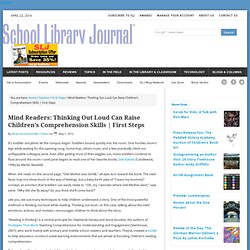

The Picture Book Teacher's Edition. Bookinitat50. Wordless Picture Books. Storytime Standouts looks at wordless picture books and why they belong on every child’s bookshelf Wordless and almost wordless picture books rely exclusively on illustrations to tell a story or convey facts.

Some wordless and almost wordless picture books have a small amount of text but most do not have any text at all. Wordless and almost wordless picture books encourage children to take an active role in telling a story. Typically, when enjoying a wordless picture book with an adult, the illustrations and meaning are discussed, and as a result of the conversation, the child’s language development is stimulated. Great wordless picture books clearly show action and sequence so the narratives are easily understood.
Wordless and almost wordless picture books can be enjoyed in any language or in many languages. We invite you to check out our Wordless Picture Book board on Pinterest Storytime Standouts Wordless & Almost Wordless Picture Books for Preschool and Kindergarten See On. Best of Blogs: Writing Strategies. Videos. The Raven Cycle Ravenwood Regarding....

Remote Control Ricky Ricotta Rissa Bartholomew's Declaration of Independence Rodrick Rules Rosa Rose Rose Sees Red Ruby Bridges Goes to School: My True Story The Ruby Key Ruined Rules Same Difference Sassy Scarlett Fever Scholastic Book of World Records 2014 Scholastic Discover More The Scorpio Races Sea Change The Search for WondLa Secret Identity Crisis Seekers The Seer of Shadows Sellout Shadow Shadow Wolf Sharks Sheep Shiver Sidekicks Sink or Swim Sisters Grimm Six Days The Sixties Trilogy Skeleton Creek Skinny Skippyjon Jones Skippyjon Jones in the Dog-House Slam Dunk!
Under the Same Sun The Underland Chronicles Ungifted The Very Hungry Caterpillar Vespers Rising Violet Raines Almost Got Struck by Lightning The Year My Sister Got Lucky You Are Not Here Zen and the Art of Faking It Zen Shorts Zoe's Room Zoobreak Zora and Me Inside the Classroom Timely Topics Webcasts. Mind Readers: Thinking Out Loud Can Raise Children’s Comprehension Skills.
It’s toddler storytime: let the rumpus begin!

Toddlers bound quickly into the room. One hurdles mom’s legs while waiting for the opening song. Some hop, others roam, and a few practically climb our unflappable colleague Janie. Even after getting most of their wiggles out, many toddlers continue to float around the room—until Janie begins to read one of her favorite books, Owl Babies (Candlewick, 1996) by Martin Waddell. When she reads on the second page, “Owl Mother was GONE,” all eyes turn toward the book. Like you, we use many techniques to help children understand a story.
“Reading is thinking” is a central principle for Stephanie Harvey and Anne Goudvis, the authors of Strategies That Work: Teaching Comprehension for Understanding and Engagement (Stenhouse, 2007), who work mainly with primary and middle school readers and teachers. In storytime we ask children the same types of questions that efficient readers might ask themselves. Successful readers need to do two things well. www.txla.org/sites/tla/files/groups/CRT/2x2/docs/2x2-2013Labels.pdf. www.txla.org/sites/tla/files/groups/CRT/2x2/docs/2X2_Activities13.pdf. Comic Master. Graphix. BookTalk.